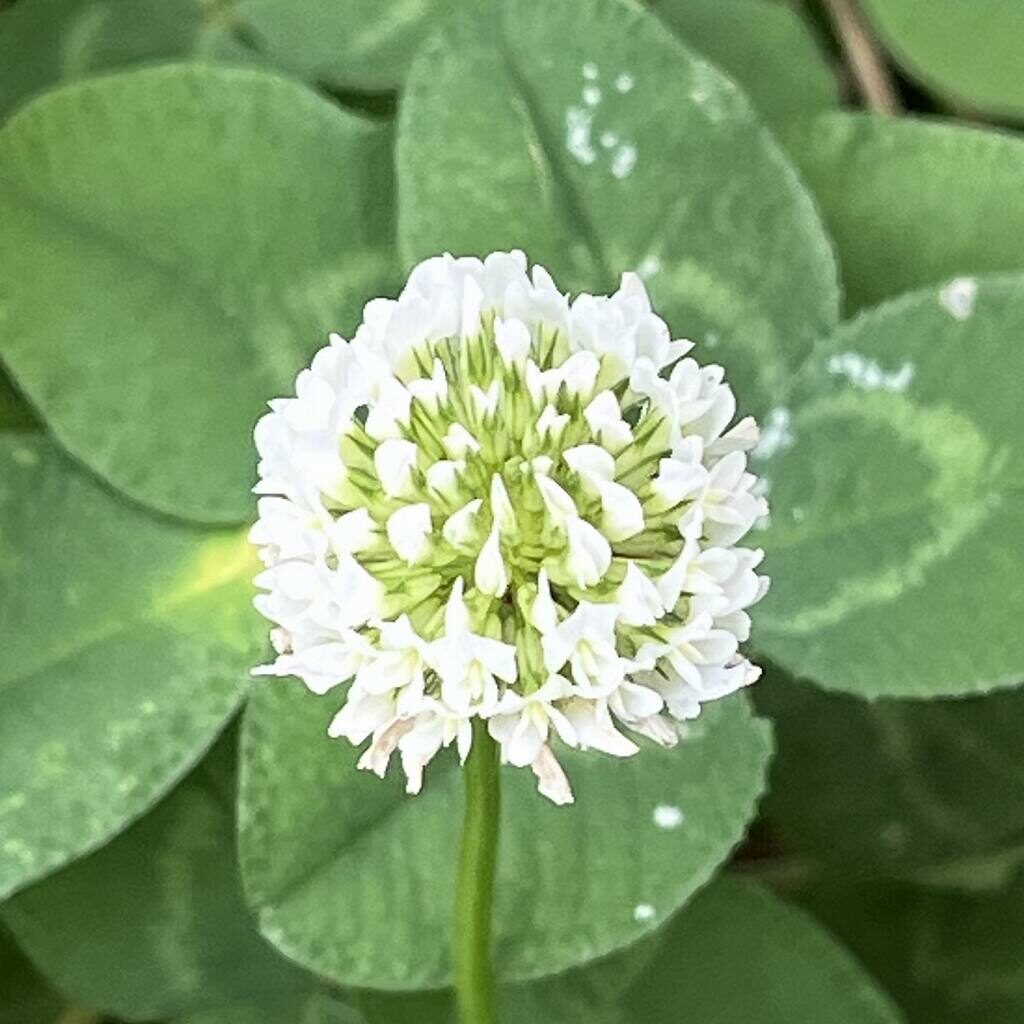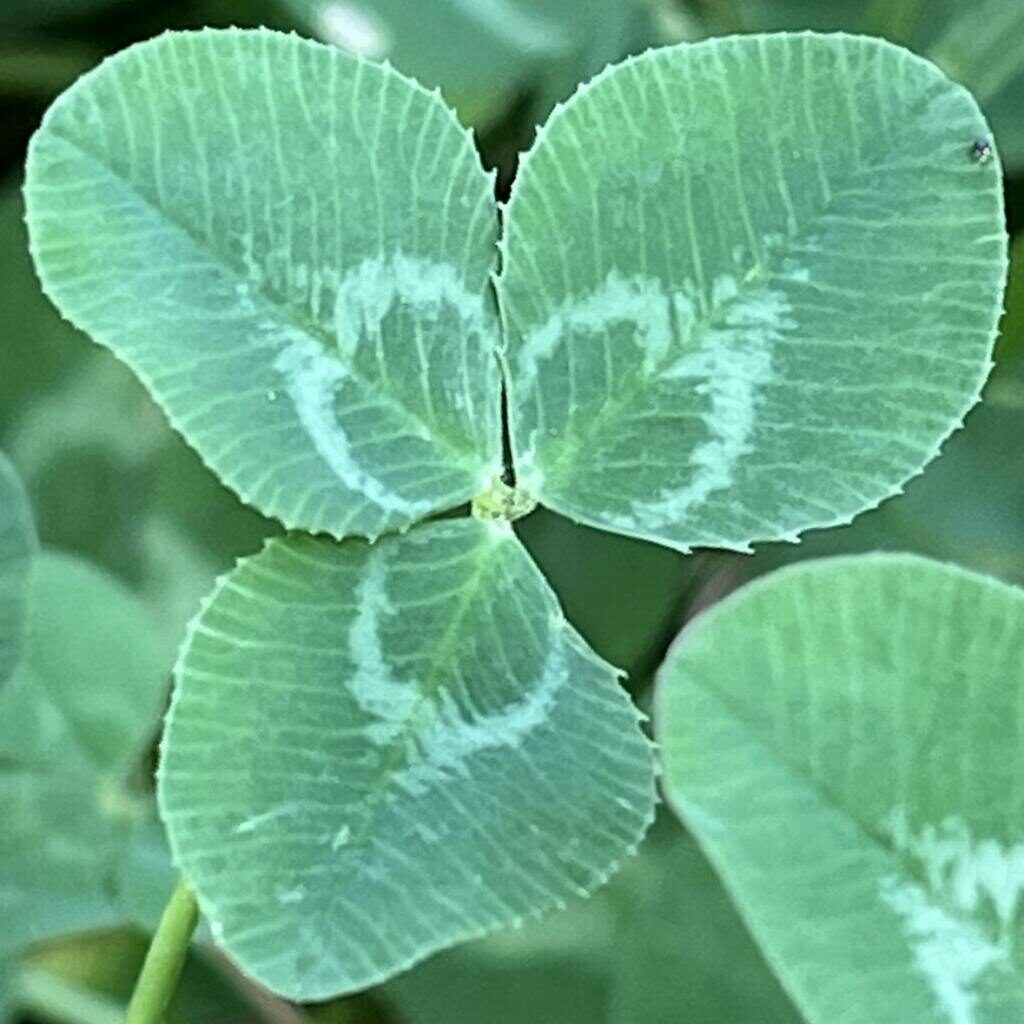シロツメクサの花は白く小さく、たくさん集まって真ん丸。葉は信頼、希望、愛の3枚に幸運の1枚が加わって「四つ葉のクローバー」です。
The flowers of white clover are white and small, and many gather together to make a sphere. The three leaves meen trust, hope, and love. With the addition of one of the lucky ones, it becomes a “four-leaf clover”.
【仮名】シロツメクサ
【和名】白詰草
【英名】White Clover
【学名】Trifolium repens
【誕生】05/ 09, 05/ 27, 05/ 29, 06/ 03, 06/ 17
【開花】04, 05, 06, 07, 08月
【花色】White



シロツメクサ
シロツメクサの自生
シロツメクサはマメ科の多年草です。原産地は欧州で、牧草として世界中に拡大。日本も江戸時代に移入され、帰化して各地に広がりました。北海道から沖縄まで分布し、道端、土手、野原、荒れ地などで自生。夏の暑さに弱いものの、踏みつけや刈り取りに強く、繁殖力が旺盛です。
シロツメクサの和名
シロツメクサの和名「白詰草」の由来は江戸時代、壊れやすいガラス製品などをオランダから輸入する際、箱の中に衝撃緩衝材として乾燥させた白花の茎葉を一緒に詰めたから。また、小葉の真ん中に白い「ハ」の字の模様が入るため、爪の半月に見立てて「白爪草」とも書かれます。
シロツメクサの英名
シロツメクサの英名クローバーの由来はラテン語で棍棒を意味する「クラーワ」です。ローマ神話でヘラクレスが持っていた棍棒の先端に3つの瘤がついていて、それが英語の「クラブ」に。ラテン語の属名トリフォリウムは「三つ葉」、種名ルペンスは「匍匐する」という意味です。
シロツメクサの姿形
シロツメクサの茎は地面を這い、節々から根を伸ばします。葉は互生の3小葉で葉柄が長く、卵形の小葉は夜になると閉じて二つ折りに。花々は白く小さく、たくさん集まって丸くなります。小花は蝶形で萼筒が尖り、受粉すると褐変して下垂。花後は莢ができ、中に種子が入ります。
シロツメクサの利用
シロツメクサはタンパク質に富むマメ科牧草で、炭水化物に富むイネ科牧草とともに畜産で利用。根粒菌が着生して窒素を固定する緑肥として地力も向上します。濃厚な蜂蜜が得られる蜜源植物であり、公園の芝生代わりや庭園の雑草抑制に。食用や薬用のほか、首飾りにもなります。
シロツメクサの逸話
シロツメクサは「四つ葉のクローバー」が幸運の象徴です。これは小葉3枚が「信頼」「希望」「愛」で、4枚目に「幸運」が加わるから。小葉4枚は十字架に似ているので、魔除けにも用いられました。さらに、五つ葉は「金運」、六つ葉は「名誉」。七つ葉は「無限の幸福」です。
White Clover
White clover is a perennial herb of the Fabaceae family. The place of origin is Europe, and it had spread all over the world as a pasture. Japan was also introduced during the Edo period, and was naturalized and spread to various places. It is distributed from Hokkaido to Okinawa and grows naturally on roadsides, banks, fields, and wastelands. Although it is vulnerable to the heat of summer, it is strong against trampling and reaping, and has strong fertility.
The origin of the Japanese name “white packing grass” for white clover is that in the Edo period, when fragile glass products were imported from the Netherlands, dried white flower foliage was packed together in a box as a shock absorber. In addition, since the white “V” -shaped pattern is placed in the middle of the leaflets, it is also written as “white claw grass” as if it were the half moon of a claw.
The origin of the English name white clover is “clava” which means a club in Latin. In Roman mythology, Hercules had the club which attached three bumps on the tip, which became the English “club”. The Latin genus name Trifolium means “three leaves” and the species name repens means “crawling”.
The stems of white clover crawl on the ground and grow their roots from the nodes. The leaves are alternating three leaflets with a long peduncle, and the oval leaflets close and fold in half at night. The flowers are white and small, and many gather to make a sphere. The florets are butterfly-shaped and have sharp stalks, and when polluted, they turn brown and hang down. After the flowers, pods are formed and seeds are contained inside.
White clover is a protein-rich Leguminosae grass and is used in livestock farming along with carbohydrate-rich Gramineae grass. It also improves soil fertility as a green manure in which Rhizobium grow and fix nitrogen. It is a honey source plant that can obtain rich honey, and is used as a substitute for lawns in parks and for controlling weeds in gardens. In addition to being edible and medicinal, it can also be used as a necklace.
“Four-leaf clover” is a symbol of good luck in white clover. This is because the three leaflets are “trust,” “hope,” and “love,” and the fourth is “luck.” The four leaflets resemble a cross, so they were also used to protect against evil. Furthermore, the five leaves are “money luck” and the six leaves are “honor”. Seven leaves are “infinite happiness”.


